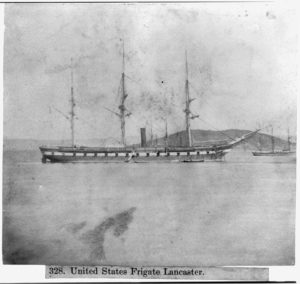Robert Burch on “The U.S. Navy in California”

A post-war photo of the USS Lancaster, commissioned in 1859, and served in the Pacific during the Civil War
The U.S. Navy’s history in the Pacific began with the formation of the U.S. Navy Pacific Squadron in 1821. The squadron consisted of only six warships and an auxiliary vessel under Commodore John B. Montgomery in April 1861. This small force was reinforced by another three warship, two auxiliaries and a shore-based U.S. Marine detachment over the next four years. On the opposing side, the Confederates were represented by only two privateers from the Atlantic Ocean and another three privateer plots originating in the Pacific late in the war that caused widespread fear in California coastal communities. In the end, no traditional ship-to-ship naval engagement or coastal raid occurred. Additionally, the critical monthly gold ships out of San Francisco that financed the Union war effort were never interrupted. This presentation will examine the ships, bases, and operations of these two small naval force as well as the U.S.S. Sacramento, named after the state capital, and the Russian Pacific Squadron’s much publicized and extended visit to San Francisco in 1863-64. This naval action is another forgotten aspect of California’s participation in the American Civil War.
Bob Burch is a native Californian from Santa Clara County, a retired U.S. Army colonel and graduate of San Jose State University where he read U.S. military history. He is also a graduate of the U.S. Army Command and General Staff College and the U.S. Navy War College. A lifetime student of the American Civil War, he read his first Civil War book in the fifth grade. As a young boy he was mesmerized when watching John Ford’s The Horse Soldiers (1959) starring John Wayne on the television rerun channels. He has visited all of the principle and most secondary Civil War sites during his 30-year military career, including multiple week-long visits to Gettysburg, his favorite battlefield site. Like most CWRT members across the county, he desires to understand his home state’s role in the war. He collected material for this presentation for over ten years followed by several years of analysis. This series documents his research in great detail. Time allows only key points to be presented. Numerous period photographs and magazine drawings are included for visual effect with the intent of comprehending California’s role in the Civil War.
